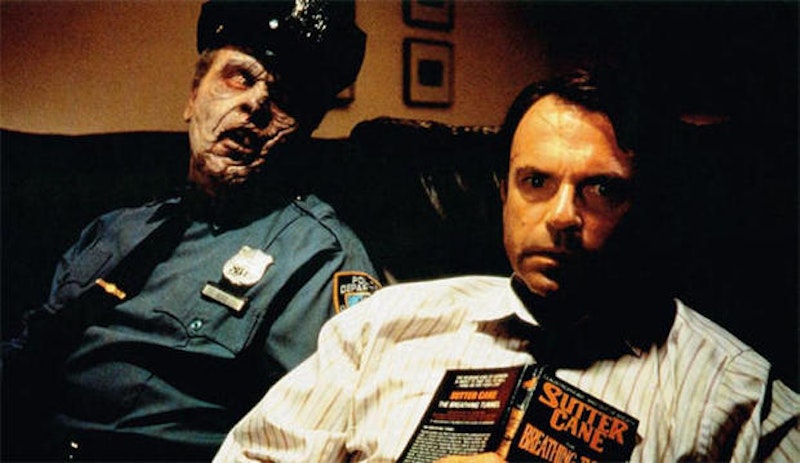When John Carpenter’s In the Mouth of Madness came out in 1995, the reviews were mixed. Critics weren’t exactly negative but almost all concluded that something was missing from Carpenter’s new exploration of horror. Apparently, it was disjointed and too weird to be viewed from a holistic lens. Since then, like most films that aren’t fully embraced by the critics (and critics are often very wrong in their assessment), In the Mouth of Madness has become a cult film—not only a look at the 1990s film scene but also an intriguing view of how horror is viewed over time.
The film opens in a lunatic asylum. A new patient by the name of John Trent (Sam Neill) has arrived. Trent’s an insurance claims investigator, hired by Jackson Harglow (Charlton Heston) to find Sutter Cane, a writer that’s gone missing. Since Harglow’s the top executive of the publishing company that publishes Cane’s bestsellers, it’s in his best interest for Cane to be found.
Joining Trent is Linda Styles (Julie Carmen), Cane’s editor and a fan. Trent’s an intelligent investigator. He’s never fooled and he can spot a fraud immediately. In this case, he’s convinced that it’s all a publicity stunt by Sutter Cane and the publishing company to raise the sales of his long-awaited book titled In the Mouth of Madness.
Trent hasn’t read any of Cane’s work, and he’s unaware of the effects Cane’s books have on the readers. They enter into a strange frenzy that causes them to go mad. By the end of the film, we witness a mass psychosis of violence and death, presumably caused by the Sutter Cane phenomenon. Trent puts pieces together and concludes that Cane must be hiding in a town called Hobb’s End (a partial title of one of Cane’s books). The town doesn’t exist anywhere on the map but Trent claims that it may be too small to be included on the map, and that it’s worth looking into.
As he and Linda find Hobb’s End, strange things begin happening. Linda’s certain they’re stuck in one of Cane’s novels. Carpenter creates an amalgam of horror genre tropes: from Stephen King to Dario Argento to H. P. Lovecraft. At this point, the film takes a turn into the unknown horror, constantly blurring the line between reality and fiction.
The once calm, cool, and arrogant Trent is beginning to lose his mind. No matter how hard he tries, he can’t escape the fictional hell that’s been forced upon him by Sutter Cane. In the meantime, the question arises: where is Sutter Cane? He’s eventually found (played by Jürgen Prochnow) in an abandoned church, wielding his power over both reality and fiction. Trent’s a prisoner of Cane’s world, and there’s nothing he can do about it.
In the Mouth of Madness functions on several levels. Carpenter comments on the prevalence of mass hysteria and collectivism, and how a popular phenomenon can have an influence on people. Can they really change their disposition and abandon all reason just to get a hit of Sutter Cane drug? Apparently, yes. People are dumb and superficial enough to not care about their sovereignty or more importantly, sanity.
Another significant factor in Carpenter’s vision is that this is a meta-film. It comments on itself (Cane’s book being the same title of Carpenter’s film), and once again, it blurs the line between fiction and reality. The images that move before our eyes further enhance and confirm the inward commentary on art and cinema.
By far, the most obvious element of Carpenter’s film is the relationship between art artifact (in this case, the novel) and its creator. Although it has been assumed by most critics that John Trent is merely John Trent, it’s unclear whether this is true. Carpenter mischievously plays with an idea of identity, leaving one puzzle after another for us. What if John Trent is Sutter Cane himself? Or if Sutter Cane is John Trent? Who’s the actual character in the novel/film and who’s the creator?
A novelist can be cruel. Much like Dr. Frankenstein, he creates a monster, yet is a beast himself. He’s merciless with what happens to his characters, and his existence as a writer is predicated by the fact that sadistic violence is inevitable and necessary. This is especially true of horror writers.
By the end of the film, John Trent has convinced himself that he’s fiction. But what if Trent is the actual novelist? Couldn’t he have entered into the mouth of madness so much that he hasn’t been able to differentiate between fiction and reality? Suddenly, the madness he has created to be released into the hungry public, has become his own. He’s stuck in a loop of literary insanity despite the fact that he proclaims sanity.
It’s not far-fetched to say that the consciousness of a writer and consciousness of a character can become one. Sometimes, we describe this as a literary alter ego, but never assign danger or uneasiness to it. Instead, an alter ego is an entrance to complete freedom. There’s no such thing as absolute freedom because if it’s found, it results in amorality, nothingness, and isolation.
For John Trent, there’s no freedom. Either he has created this hell for himself or someone else has cruelly placed him into the box he can’t get out of. This includes the alter ego of being an insurance claims investigator—a brilliantly arrogant “character” stuck in a neo-noir.
Maybe even Sam Neill was stuck for the time being in the world of John Carpenter, until he was mercifully released from the screen. Nevertheless, the madness continues. In the end, John Trent/Sutter Cane/Sam Neill watches the very film he has just been in, laughing at the insanity, as he slowly transitions into the absurd knowledge and acceptance that the loop will never be broken.

